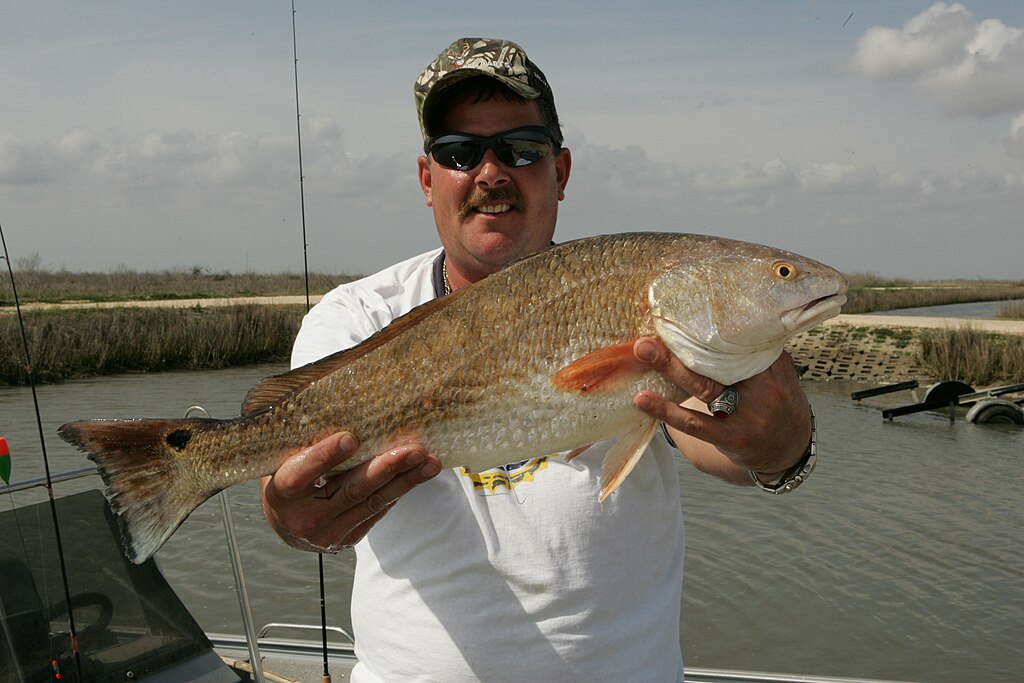
Red Drum
Scientific Name: Sciaenops ocellatus
Also known as: Redfish, Spottail Bass, Channel Bass
General Description
The Red Drum, commonly known as Redfish, is a popular and sought-after species found along the coastal waters of the Gulf of Mexico and the Atlantic Ocean. These fish are easily recognizable by their vibrant reddish-brown coloring and characteristic black spot at the base of their tail. The body of the Red Drum is long and streamlined, allowing for swift movement through the water, and their size can vary greatly, with adults typically ranging from 15 to 45 inches long and weighing between 5 to 50 pounds. Some particularly large individuals have been recorded at over 90 pounds.
Red Drum are known for their strong, determined fight when hooked, making them a favorite among anglers. These fish are opportunistic predators, preying on smaller fish, crabs, and shrimp, which they hunt in the shallower coastal areas. Red Drum have a distinct drumming sound produced by vibrating muscles around their swim bladder, which is where they get their name. Known for their resilience and ability to adapt to various environments, Red Drum are a prized catch for both recreational and commercial fishing alike.
Where to Find Them
Red Drum are most commonly found in warm coastal waters, making them abundant along the shores of the Gulf of Mexico and the Atlantic Ocean, from the Carolinas down to Texas. They thrive in estuaries, bays, and shallow coastal waters, often frequenting areas with sandbars, oyster beds, and submerged structures, where they can find an abundance of food. These fish are particularly abundant in the southern U.S., from Florida up to Virginia, with significant populations found in Louisiana, Texas, and the Carolinas.
While they are primarily a coastal species, Red Drum can also be found in brackish rivers and lagoons where they migrate to spawn. Juvenile Red Drum often inhabit estuaries and tidal creeks, while adults tend to prefer deeper waters with abundant forage. The species is also found inshore during the summer months when they venture into shallower waters to feed and breed. In winter, they tend to migrate to deeper waters to avoid colder temperatures. The Gulf Coast is a hotspot for Red Drum, especially in areas like Galveston Bay, Mobile Bay, and the waters around Charleston, South Carolina.
Best Baits Section
Live Bait Options
- Shrimp
- Finger mullet
- Menhaden
- Mud minnows
- Crabs
Artificial Bait Options
- Soft plastics (minnow imitations)
- Spoons (gold, silver, or copper)
- Jerkbaits (for targeting shallow Red Drum)
- Swimbaits (slow-sink models)
- Poppers (for surface action)
- Crankbaits (for deeper water fishing)
Best Fishing Methods
Red Drum are known for their aggressive strikes, and there are various methods to target them. Surf fishing is one of the most popular methods, especially for anglers along the Atlantic and Gulf coasts. Casting live or cut bait, such as mullet or shrimp, from the shore or from a boat can produce great results. For surf fishing, heavier rods and reels are required to cast into deeper water, where larger Red Drum often reside.
Another effective method is casting artificial lures, particularly soft plastics, jerkbaits, or spoons, which can be retrieved in various ways to imitate the movement of prey like shrimp and small fish. These lures can be used from a boat, kayak, or the shore, depending on the fishing conditions. If you’re fishing in shallow waters, popping corks can also be effective, as they create noise and movement on the surface, attracting the attention of Red Drum.
Fly fishing for Red Drum is also growing in popularity, especially in the shallow estuaries and flats where the fish feed. Larger flies that resemble shrimp or baitfish work well for these fish. When fly fishing, anglers should focus on the right presentation to ensure the fly stays near the bottom or mimics the movement of prey.
Drift fishing with live bait is a good method, as the bait naturally drifts through the Red Drum’s habitat. This technique can be especially effective in deeper waters. If you’re fishing for Red Drum in the deeper channels of estuaries, use weighted rigs to keep your bait at the desired depth.
Summary
Fishing for Red Drum offers a rewarding challenge for anglers due to the species’ aggressive nature and strong fight when hooked. Known for their beautiful reddish-brown coloring and distinct black spot, Red Drum are found primarily in the warm waters of the Gulf of Mexico and the Atlantic Ocean, particularly in estuaries, bays, and shallow coastal areas. They are a versatile species, adaptable to both saltwater and brackish environments, which makes them a popular catch in a wide range of coastal habitats.
Red Drum are commonly found in the summer, often moving into shallower waters to feed and breed, and they are targeted with a variety of methods, including surf fishing, boat fishing, and fly fishing. Live baits like shrimp, mullet, and menhaden are the most popular choices, while artificial lures such as soft plastics, jerkbaits, and spoons also yield great results. Surf anglers and boaters alike will find success with live or cut bait, while fly anglers targeting shallow flats can use large shrimp or baitfish imitations for the best chance of success.
The Red Drum’s aggressive strikes and powerful fight make them a top choice for anglers looking for a thrilling fishing experience. Whether you’re surf fishing on the Gulf Coast or targeting trophy-sized fish in the Carolinas, fishing for Red Drum provides exciting opportunities for both beginners and seasoned anglers alike.


